What are New Product Development Services? Process, Features, and Benefits

For startups, time is the most important asset. Raw ideas either turn into viable products that meet market needs or run the risk of fading away. This is how new product development services become critical; they provide the backbone, specialist knowledge, and resources that need to be in place so startups can create products that launch well and scale rapidly.
The path from idea to launch in most cases is anything but linear. Limited funding, nebulous roadmaps, and the risk of going to the customers with an inadequately refined product are some of the challenges startups faces. If uncontrolled, these issues may delay progress for a long time, drain resources, and reduce the chances of lasting success.
Startups working alongside professionals in a new product development project acquire tested methodologies, state-of-the-art technologies, and industry insights. Such services ensure that each stage of the development process-from market research and prototyping, testing, and scaling-is a valid extension of business requirements. In today’s competitive environment, startups that nurture structured new product development approaches are far more open to innovation, adaptation, and growth.
Table of Contents
What Are New Product Development Services?
The services of new product development constitute a bundle of solutions that help startups bring their ideas into lucrative products. The services integrate strategy, design, technology, and innovation under one roof. With expert consultation, the startups stand to grow faster, take fewer risks, and make sure that their products fit market and customer needs.
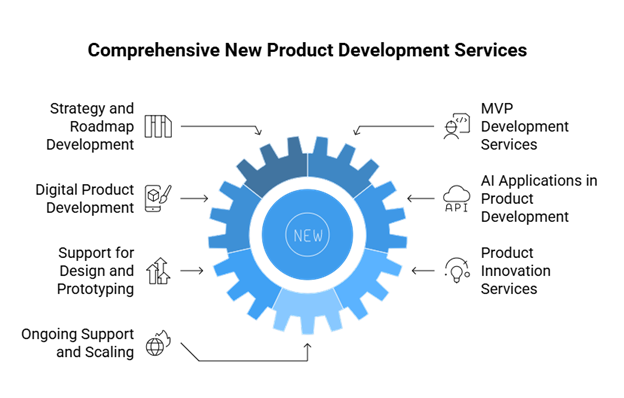
1. Strategy and Roadmap Development
Every successful product stems from a strong strategy. New product development services thus offer startups a comprehensive market analysis, competitor benchmarking, and financial feasibility studies in developing clear roadmaps. Being strategically aligned, the startups would be able to efficiently prioritize resources, minimize risks, and focus on those products which have an actual market demand.
2. MVP Development Services
Building a full-scale product at once can be risky for new startups. Hence, they seek MVP development services to implement a minimum viable product and test essential features with early adopters. With the help of professionals, they can quickly validate ideas, collect user feedback, and implement improvements based on data, thereby setting the path for scaling. New product development services ensure that MVPs are produced effectively yet remain flexible for future upgrades.
3. Digital Product Development
Being tech-driven, startups usually go for this type of development to create mobile applications, web platforms, and SaaS solutions. With varying expertise, startups can design a scalable digital product perfectly integrated with emerging technologies. New product development services provide startups with UX/UI interfaces, cloud-based solutions, and agile-level expertise, allowing the startup to efficiently innovate the digital-first product.
4. Artificial Intelligence Applications in Product Development
AI profoundly reshapes the production and optimization of products. By applying AI in product development, tech startups can enable various possibilities for predictive analytics, personalization, and process automation. Startups, through new product development service providers, access artificial intelligence frameworks, machine learning models, or advanced data insights that allow their products to stand out in a market where almost all products look alike.
5. Support for Design and Prototyping
Good design and prototyping are necessary to ensuret acceptance and scaling by the users. New product development service providers will offer their assistance to startups for designing interactive prototypes, testing design flows, and collecting feedback before embarking on full-fledged development. Hence faster time-to-market and assurance that the product will be customer-aligned from day one.
6. Product Innovation Services
Startups must continuously evolve to stay relevant. Product innovation services allow them to explore new trends, incorporate state-of-the-art features, or even change direction and reposition themselves. Offering ideation capacities, design, and market adaptivity keeps startups competitive. Informed by new product development services, such innovation is made methodical instead of an experiment into the unknown.
7. Ongoing Support and Scaling
Building a product is just the beginning. Startups require continuous support to enhance features, fix bugs, and adapt to changes in the market. The new product development services offer support after the launch, including tool monitoring and strategy planning for scaling the product worldwide. This allows new startups to get out of survival mode and into the higher mode of sustained existence.
What is the Product Development Process?
The product development process is a structured journey that takes an idea and turns it into a product available on the market. This serves as a roadmap for startups to navigate in an efficient manner, mitigating risks along the way and ensuring scalability. The entire process, when pursued along with professional new product development services, aids in transforming concepts into solid products that foster growth.
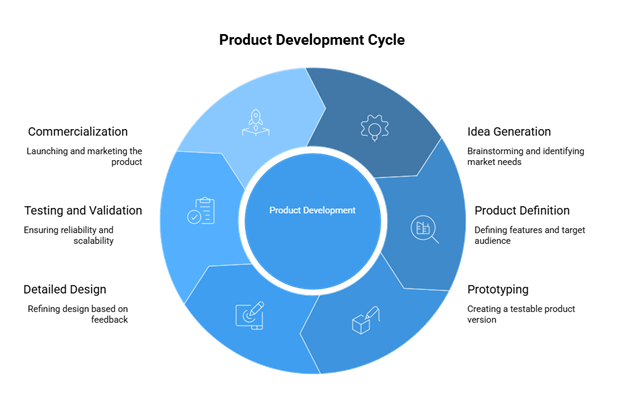
1. Idea Generation
Every product begins with an idea, although not all ideas deserve to be pursued. This phase focuses on brainstorming and finding opportunities that fill or solve a clear market requirement. Startups generate ideas mostly from customer feedback, competitor analysis, or emerging trends. With such services for new product development, startups can filter and prioritize their concepts in terms of feasible implementation, market demand, and sustainability in the long run.
2. Product Definition
Once an idea is showing potential, the product must now be defined in terms of conception of its features, functionalities, and purpose. This is the point where startups must define their audience and value proposition. Clear definition of a product helps in aligning business and customer expectations. Such professional and new product development companies give market insights, technical assessments, and strategic direction in sharpening this vision and ultimately reducing investment risks.
3. Prototyping
Consider prototyping as developing a rudimentary form of the product in order to test stereoscopic operations and provide initial user feedback. Unfortunately, many startups neglect this stage, but since it involves ideas validation before substantial resource commitment, it is certainly critical. In fact, through new product development services, an expedited go-to-market approach is attained through access to design expertise, rapid prototyping tools, and structured feedback loops, thus minimizing the costly errors along the way.
4. Detailed Design
Refinement based on user feedback and technical feasibility occurs after prototype validation. During this step, the design of the product architecture, interface, and user experience is finalized. For a startup, conducting detailed design work can be impossible without incumbent knowledge. By investing in new product development services, the startup can access UX/UI specialists who incorporate industry best practices to ensure that the product remains intuitive, competitive, and user-friendly.
5. Testing and Validation
If its tests are not rigorous enough, a product can never be judged as complete. During this step, form testing, fixing of bugs, and evaluation of performance are meant to explore at best the level of reliability before the launch. Many startups don’t have a structured testing framework; this leaves room for post-launch issues. Through new product development services, startups get the opportunity to run tests in various scenarios ensuring they turn out with a product that is stable, scalable, and meets customer expectations.
6. Commercialization
Commercialization represents the transition from development into the market. It involves distribution planning, sales strategies, marketing, and advertising. Startups must finely calibrate the time, price, and promotions for better adoption. Using product development services makes commercialization strategies more data-aligned, well-orchestrated, and customer needs oriented, giving startups better chances to get some early traction.
Read More: Top Product Development Trends to Watch in 2025
What are the New Product Development Benefits?
New Product Development, more than the creation of new products, denotes the path for growth, competitiveness, and eventual sustainability. An investment in innovation coupled with market need-view of products can help businesses sustain their position in the market, increase profit margins, and build stronger customer relations. The following are listed as the key benefits of undertaking an NPD approach:
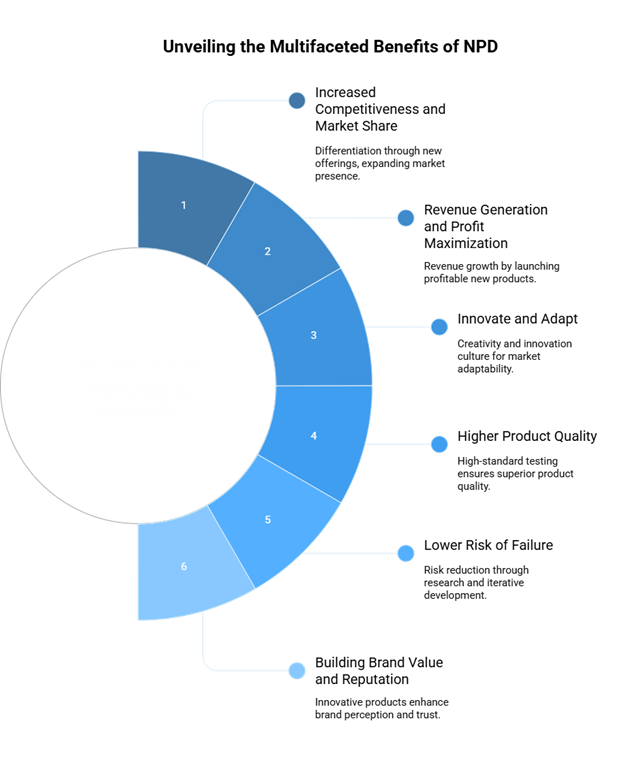
Increased Competitiveness and Market Share
By creating new offerings that target specific customer needs, NPD creates a differentiation for the company with its competitors. This opens up new markets, allows incumbents to gain a larger market share, and provides a competitive edge in continuous innovation.
Revenue Generation and Profit Maximization
Launching new product can generate revenues and sales opportunities, thus leading to revenue growth. When done correctly, new product development (NPD) serves the dual-fold purpose of rendering profits for the company whilst granting maximum returns by increasing market share and reducing production costs in the long term.
Innovate and Adapt
NPD produces a culture of creativity and innovation to keep fresh ideas coming. It enables managers to adapt quickly to rapid changes in customer needs and market trends so that their products are made future-proof against contingencies.
Higher Product Quality
NPD gives assurance to provide new products that are tested, prototyped, and validated at very high standards. This customer-centric approach furthers customer satisfaction, repeat sales, and loyalty.
Lower Risk of Failure
There are several ways NPD reduces risks through market research, concept testing, and iterative development. Early identification of flaws in the product allows constant refinement, saving the company from costly errors in launching unproven ideas.
Building Brand Value and Reputation
Constant production of new products is the basis for good market perception: innovative, high-quality products ensure that the company is viewed as a leader in its industry. The associated new product launches increase brand recognition and trust.
Let’s Build Your Product from Start to Success
What is the New Product Development Strategy
A product development strategy is more than an idea-to-launch plan. It is a complete framework ensuring that a product is new or improved on the market successfully. It would provide direction, minimize risks, and keep the organization focused on customer expectations and overall business objectives. Without a defined strategy, no matter how innovative a product is, it is always at risk of failure from lack of focus, poor execution, or misalignment with market demand.
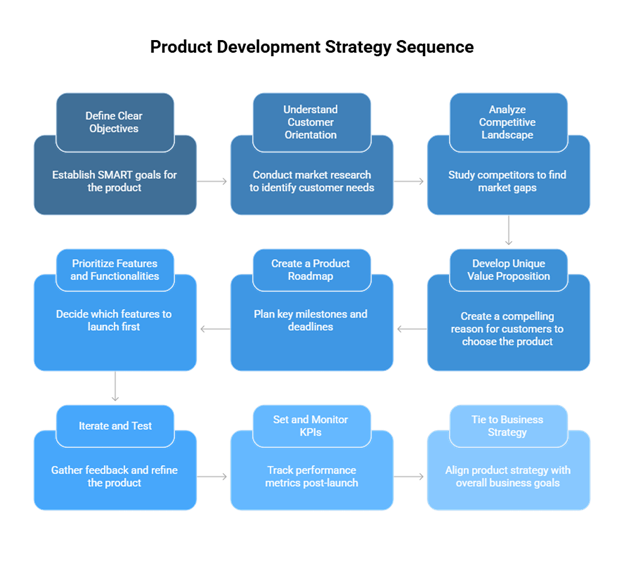
Elements of a Product Development Strategy
Define Clear Objectives
Every product journey has to begin with objectives that are specific, measurable, achievable, relevant, and time-bound (SMART). These objectives serve as standards upon which success can be judged and upon which decisions might be made during the development lifecycle.
Understanding Customer Orientation
Market research helps locate customer needs, preferences, and pain points. Having sound knowledge about the target audience ensures that the product resonates with their needs.
Analyze the Competitive Landscape:
Studying competitors’ strengths and weaknesses leads to discovering market gaps and enables creation for differentiation. This competition knowledge keeps the product from blending in among other competitors.
Develop a Unique Value Proposition:
Customers go for products that solve problems better than any other alternative they already know about. The value proposition persuasively talks to the customer about what makes your product different and worthy of consideration.
Create a Product Roadmap:
A roadmap delivers clarity about key milestones to be achieved, deadlines, and the resources required for progression.
Prioritize Features and Functionalities:
Not necessarily every feature needs to be launched at once. Splitting those that are must-have functionalities and those that are nice-to-have helps in early delivery of value and leaves room for development during post launch revisions.
Iterate and Test:
Whether beginning with initial prototypes or finalizing product beta stages, feedback should be garnered at each step so that the product evolves with the input received from actual users. Iterative polishing yields increased quality, usability, and customer delight.
Set and Monitor KPIs:
After launch, metrics that track business performance in the area of adoption rates, customer satisfaction scores, and market share offer a lot of information on adjusting the on-ground strategies.
Tie to Business Strategy:
The product development strategy should, more often than not, be a complement to the wider organizational goals: market expansion, revenue generation, digital transformation.
Why Do Startups Struggle Without NPD Services?
Many start-ups underestimate structured assistance with successful product development. In the absence of professional new product development services, these companies are simply unable to muster the necessary expertise, resources, and processes needed to deliver to market expectations. Such barriers result in poorly made products, drained investments, and slower growth-individually significant contributors to startup failure.
1. Lack of Product-Market Fit
No matter what a product does or how well it’s designed, if it does not satisfy the needs of anybody who requires such fulfillment, then it surely cannot thrive. In their lack of acquiring new product development services, startups tend to neglect vital actions such as market validation or even user research. As a consequence, they may get into building solutions that no one really needs: an oft-cited big-name reason for startup failure, according to industry reports.
2. Poor Product Quality
Quality is what makes consumers trust and use the product. Startups without an organized NPD process cannot keep high standards of design and reliability. The resulting customer dissatisfaction can lead to harsh word-of-mouth and low adoption. Professional product development services allow the product to be tested, prototyped, and assured of quality so that it is ready to hit the market.
3. Development of High Cost
A product developed without expertise by in-house teams can wash away the financial resources of any startup. Startups overspend, looking out for unnecessary features, engaging in inefficient workflows, or managing resources poorly. Contrarily, new product development services cut away from all these wastes to contain cost and increase production for the startup.
4. Slow Time-to-Market
Speed is the key to startup success in fast-moving sectors. Inefficient work systems may delay product launches while competitors reap the advantages. Product development services lay down structured roadmaps and allow extensions of agile methodologies, which startups can use to quickly move from ideation to commercialization. Quick launch equates to market capture, which in turn increases investor confidence.
5. Limited Innovation
Startups base their livelihood on innovation but may find it difficult to come up with new, competitive ideas without some kind of support system. Services, including market research, concept testing, and iterative design, bring to the surface opportunities that startups might overlook. Through product development services, startups can maintain continual innovation while ensuring that new ideas cater to market demand.
6. Difficulties in Scaling
Scaling a product is not an easy task; it is a matter of managing complexities on the forefront of distribution, support, and customer experience. Startups without set NPD processes will find the scaling experience chaotic and unsustainable. New product development services, thus, provide a company with structured systems that help them expand operations with ease while keeping product quality consistent.
7. Problematic Cash Flow
Poorly planned product development can lead to cost overruns and poor sales. For a startup having limited access to capital, this result becomes serious; it experiences cash flow problems and even shuts down. Partnering with development services will ensure that the new product will be created with financial discipline; there will be better forecasting and alignment of development costs and revenue expectations.
The difference: slight variations in word usage or syntactical arrangements throughout the paraphrasing process ensure a generation of the text instead of word-for-word copying.
How Startups Build New Products?
Building a product is not just about having a great idea; it needs structure, discipline, and adaptability. Lean methodologies and customer-centric approaches are typically adopted by startups to reduce risks and improve resource optimization. When these are combined with professional services of new product development, it helps to ensure that startups build products to serve real needs and scale effectively.
1. Idea Generation and Validation
At this stage, the major market problem is pinpointed, and solutions are pondered. Those startups perform market research to test their assumptions against competitors and, more importantly, ascertain whether an idea really resonates with their potential customers. The interesting bit is that, with new product development services, startups can get expert insight and research capabilities to help them validate product-market fit early and, consequently, avoid costly accidents further down the line.
2. Development and proof of concept
Once promising ideas are identified, startups make them into real concepts. Prototyping, user interviews, and usability testing are possibilities that can be undertaken to build early feedback. The idea is simple: polishing the ideas until they fit in the mind of a customer. With new product development services, startups consider organized prototyping support and usability analysis that speed up the process of concept validation.
3. Product Design and Development
At this point, these validated concepts get further into product designs. User feedback, technical requirements, and scalability options serve to inform and shape the development process: wireframes, feature planning, and beta builds are usual stages in this process. These professional new product development services introduce best practices of UX/UI and scalability and performance to the startup, literally converting promising ideas into concrete, well-functioning products.
4. Testing and Launch
If startups ever launch a product to market, they must test it first and thoroughly: from pinpointing bugs to identifying performance problems and usability challenges. Once the product is ready to be tested among a very small number of people for a beta phase, the inputs received could promote final tweaks. Working with new product development service providers can open up structured approaches to testing so that fewer risks are taken during launch.
5. Commercializing and Post-Launch
Launching a product is primarily a technical job, but marketing, distribution, and sales will greatly affect adoption. Subsequently, startups will have to undergo continuous performance monitoring, feedback collection from customers, and improvement settlements. Therefore, new product development services must assist in strategizing for commercialization so that a startup gains trust and momentum before they begin refining products after launch.
6. Lean Startup Principles and MVP Development
Many startups today endeavor to incorporate the lean startup principles based on being agile and iterative in learning. Building an MVP is a fundamental concept of this method: therefore, it gets distilled into only those features necessary to test the underlying assumptions. MVP professional development services allow startup teams to partner with them and get their MVPs built within a very quick timeframe, enabling their customers to review real feedback and refocus if necessary. It keeps away from anything wasteful and forces the startup teams to develop only those features that truly matter.
What Other Factors Support Startup Product Development?
While product development is deemed necessary in startups, they must also ensure their nourishment through secondary activities that decide long-term success. Elements such as team-building, financing, business modeling, and marketing research directly affect how fast the startup will grow. Upon joining all these with new product development services, will create a perfect platform for the scaling-up phase.
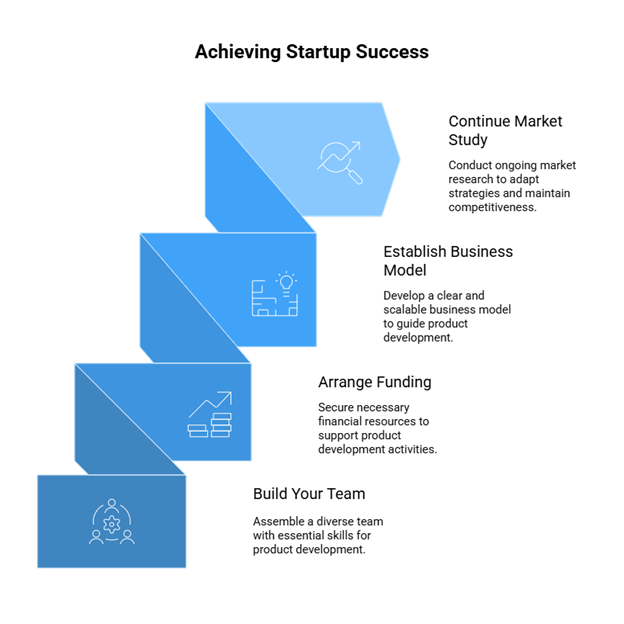
1. Build Your Team
Success is achieved with the right set of people. Product development calls for different areas of expertise, such as design, engineering, marketing, and operations. By irregularly equipped with effective product development services, startups are further enhanced by external specialists who supplement their internal talent.
2. Arranging Funding
Funding is among the biggest hurdles for startups. Without ample funds in place, prototyping, testing, and launching products get pretty difficult. Investors would like to fund startups that have structured plans and well-laid roadmaps. New product development services help by imparting well-documented processes, market insights, and professional methodologies that liven up funding pitches.
3. Establishing a Clear Business Model
A good business model can make or break a good product. Startups must identify revenue sources, pricing strategies, and paths to scalability, even at the rudimentary stage. Losing direction will cause them to burn resources quickly. And when they get help from product development services, they can synchronize product features with business goals, ensuring that product development and monetization strategies work together.
4. Continuing Market Study
At a rather fast rate, the markets keep evolving, and by some sort of demand, the consumers’ needs change. Research is ongoing so that startups can always spot new opportunities, adjust their strategies, and retain their competitiveness. Without it, the product will become irrelevant in a short period. With professional effective product development services, market research is incorporated at each stage; this offers startups real-time insights on the market needs so that they can change their offerings accordingly.
Start Your Product Development Journey
What Are Some New Product Development Examples?
With a couple of real-world examples, companies take full advantage of innovation to build scale. Entertainment giants or fast foods-the best products are those addressing customer needs, with the least compromise: either better ones or new markets entirely. Now, bearing new product development services in mind, these companies are examples of how a structured process leads to long-term success and market leadership.
1. Identifying Market Needs and Opportunities
Great products begin by spotting unmet needs.
- Netflix’s Transition to Streaming: Settling for digital streaming after recognizing the slow and painful demise of physical media created a new entertainment industry.
- McDonald’s Chicken McNuggets: These nuggets catered to an entirely new consumer base, aiding the company in expanding beyond just selling burgers.
- Taco Bell’s Breakfast Menu: The menu was expanded to catch the morning crowd, thus solidifying the idea that innovation is not solely for technology.
2. Developing New Products
Some companies create entirely new categories through bold product development.
- Beyond Meat’s Plant-Based Burgers: The increasing demand for plant-based diets was met with sustainable alternative offerings.
- Apple iPhone: The integration of communication with computing and entertainment shall never be seen again in a smartphone.
- Tesla Electric Vehicles: Promoted sustainable transportation and hence laid the foundations for high standards in EV technology.
With product development services, startups today can follow the same ways of innovation effectively.
3. Improving Existing Products
Not all innovation means creating something new, often, it’s about enhancement.
- Flyknit Technology by Nike: Gave lighter and stronger shoes, with a green performance dimension and comfort.
- Free Features of Zoom: The lifetime free entry-level services engender trust and create an impetus for purchase of upgrades.
- The Lego Ideas: Engages customers directly by turning fan designs into real products.
These examples show how new product development services can help new product companies stay grounded in their spirit.
4. Key Stages in NPD
All innovations follow critical stages:
- Idea Generation: Finding opportunities (e.g., Taco Bell breakfast).
- Concept Development: Target Market Definition (e.g., Tesla EV strategy).
- Market Testing: Concept Testing with the Client (e.g., Nike Prototypes).
- Product Launch: Launched in the market in big numbers fueled by superior go-to-market strategies.
In each stage of the definition of new product development, startups have the service of new product development providers to carry structure in execution.
5. Product-Led Growth
Some companies scale by letting the product sell itself.
- Zoom’s model: there’s free access for the users, who eventually pay for more features.
- Netflix, on the other hand, provided customization: AI recommendations insisted on retention and engagement.
New product development could be offered as a technical service to lay ground for product-led growth strategies and startups that needed quick scaling.
Why the New Product Development Process Matters for Scaling?
Scaling is one of the biggest challenges faced by startups. While a product launch is an important milestone, sustaining growth demands more than enthusiasm. A well-structured enhancement in new product development makes sure products are prepared for scalability, adaptability, and improvements toward the future. With new product development services, startups can grow faster with less risk.
1. Designing for Scalability
Most startups fail to anticipate big roadblocks in scaling production. A structured process reinforces the Design for Manufacture (DFM) principle, to ensure products are made for mass production efficiently and at the lowest possible cost. Modular design also means fewer headaches for upgrades, allowing easier updating of different versions. With the new product development services, the startup also tries to see potential bottlenecks in its supply chain and production processes at an early scale, so that these would not be a disruption when demand increases.
2. Adaptation to Changes in a Market
Markets keep evolving, and products have to evolve with them. Once a new product development process is initiated, the startup is able to monitor the needs of the customer, the strategies of the competitors, and changes in the industry. Continuous research also allows the startup to see eye to-eye with user-level features. By utilizing services for new product developments, startups can inject customer feedback straight into improvements, which gives the products ongoing relevance and differentiation in changes within the market landscape.
3. Increasing Risk and Efficiency
Scaling, increasing risk-financial, operative, and technical. The structured process decreases these risks by prioritizing tests and validations prior to gigantic launches. The testing ensures a fit between what the customer required and the product, while the validations ensured product reliability. Professional services of new product development also make the flying smoother and more predictable while also trying to get the optimum allocation of resources so that the team and budget go to high-priority scaling efforts.
4. Building Blocks for Innovation
Sustainable scaling is not only about efficiency but also about the ability to keep innovating. New product development processes offer a culture of experimentation, allowing startups to test innovative features, complement existing product lines, and make changes to existing solutions all without interfering with growth. By leveraging these done-to-help services of new product development, startups can innovate while controlling costs, thus remaining viable for ever changing markets.
5. Strengthening Competitive Positioning
Structured processes used by Startups will gain better renown and trust from investors and customers. A well-disciplined scaling attests to professionalism, perseverance, and readiness for growth. Leveraged by new product development services, startups can showcase new leadership in their markets, attract funding, and stand firm as credible players in the industry.
Startups establish a culture where scaling and innovation come together instead of opposing each other through structured new product development services.
Table: Why NPD Matters for Scaling
| Area | How NPD Supports Scaling |
| Design for Scalability | Efficient production (DFM), modular design, bottleneck identification |
| Market Adaptation | Tracks evolving customer needs, drives differentiation, integrates customer feedback |
| Risk & Efficiency | Reduces launch risks, enables smoother rollouts, optimizes resource allocation |
| Innovation Foundation | Encourages experimentation, builds culture of continuous improvement for long-term growth |
How New Product Development Services Drive Startup Growth?
For startups, growth is not just launching a product; it has to do with building something scalable, innovative, and adaptable in nature. New product development services bring together the tools, expertise, and processes that accelerate the journey undertaken by an emerging venture. They assist in closing the gap between ideas and execution and hence become vital forces for growth.
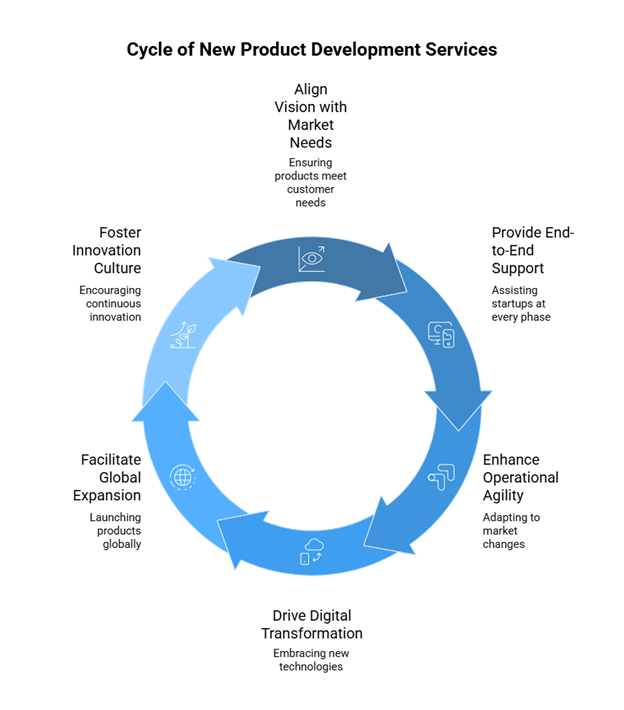
1. Aligning Vision with Market Needs
Very often startups fail because their product does not meet the customer’s needs. Product development services close this gap by utilizing market research, customer insights, and competitor analysis to ensure that the vision of a startup is aligned with real world opportunities. Alignment reduces the risk of failure and lets you build products that are relevant, valuable, and scalable.
2. End-to-End Development Support
From ideation to post-launch scaling, startups require assistance at every phase. Product development services provide help from design to prototyping, testing, and commercialization. By working with such agencies, startups can avoid fragmented workflows and enjoy a clear road map laid in front of them, thereby allowing them to spend their resources on growth rather than on solving issues.
3. Becoming More Agile in Operation
There are constraints that force startups to change with the market. The framework structure and agile method assure that through new product development, the start-up does not lose focus while gaining freedom. Because of this flexibility, team members will be able to change product features quickly, adjust timelines, take feedback constructively, and transform what could otherwise be an impediment into a springboard for innovation and faster growth.
4. Technology and Digital Transformation
In today’s startups, going digital is how they must survive. Thus, new product development services offer the startup the potential to transfer through cloud platforms, through mobile solutions, and other new technology that enhances performance and customer experience. When a startup embraces transformation into a digital start-up, it garners both efficiency and scalability to either compete with the bigger players or carve out its own territory as a home.
5. Driving Global Expansion
A large-scale launching beyond local markets must be the next big achievement for a startup. New product development services assist with localization of products into various geographies, compliances, and customer requirements. This support thus enables startups to confidently launch globally thereby opening up new revenue streams while ensuring product and operational efficiency.
6. Maintaining Innovation Culture
Long-term growth depends on constant innovation. New product development services help a startup to run iterative processes, test novel features, or even try adjacent product lines. The culture of innovation keeps startups fresh and appeals to investors and partners who see the value of a business that is adaptive and forward-thinking.
The Future of New Product Development for Startups in 2025
Fast technological change, changing consumer expectations, and a rising concern for sustainability will most definitely set the backdrop for startup product development in 2025. To survive in this fast race, a startup has to be flexible, adopt AI and automation, focus on user-centric design, and hyper-personalize experiences. Having said that, here are a few trends set to be crucial in product development.
AI-Powered Development
In a startup, the creation of new things will always be in tune with the development of AI.
This means there is supposed to be a shoulder-to-shoulder relationship between accelerated development and AI, with AI rushing through different stages of the product cycle-from ideation to creation, followed by testing and iteration-all at one speed.
- Personalized Experiences: Utilizing some kind of AI-based personalization, startups can better address the needs of individual customers or segments, hence raising satisfaction and retention.
- AI-Driven Insights: Machine learning algorithms will evolve according to trends, user behaviors, and performance data, thus guided by the suggestions for product improvements and innovations.
2. Agile and Lean Methodologies
Agility has to be a core success factor for startups.
- Rapid Iteration: Agile and lean frameworks insist on rapid product iterations, so startups must shift quickly into responding to feedback and market changes occurring around them.
- Focus on MVP: Minimum Viable Products (MVPs) exist for a reason. They are supposed to let teams test an idea and mutate it based on real-world insights.
- Continuous Improvements: Theories harboring these concepts suggest changes never cease, hence those products build on user customer needs.
3. User-Centered Design
Whatever task startups have is aimed at the production of services and products for users which should be easy to use, interesting, and user centered.
- Deep Understanding: Hardcore success provided in the wearer must mutually dissect the understanding of user necessities and pain points.
- Feedback Integration: Constant user feedback will be absorbed to guide the improvements and to make sure it is in line with market needs.
1. UX/UI Focus
From the viewpoint of design, the UX-related issues aim to ensure product adoption through ease of use and delightful interaction.
4. Environmental Sustainability
The world will never take environmental responsibilities as an option.
- Eco-Conscious Products: Startups should consider sustainable materials and processes in manufacturing.
- Circular Economy Principles: It will become a serious competitive ability now to design for longevity, reuse, and recycle.
5. Emerging Technologies
These will give way to new opportunities.
- IoT Integration: Devices would otherwise generate more functionality and more data-based insights.
- VR/AR Experiences: The virtual-augmented realities are going to be a new way to engage customers with products.
- Digital Twins: Simulated environments provide the possibility to optimize real-time environments and perform predictive analysis before actual deployment.
6. Importance of Strong Teams and Partnerships
If it is successful, it will always have been supported by the pertinent persons and collaboration.
- Agile Development Teams: Creating teams that are flexible yet technically competent will become front and center in innovation.
- Strategic Alliances and Partnerships: Such partnerships with product development organizations can open doors of opportunity for startups-interaction with specialized expertise, resources, and networks.
7. Continuous Monitoring and Improvement
Sustained growth will demand constant measurement and ability to adapt.
- Performance Tracking: Keeping an eye on KPIs will tell you how a product does in the market and how well it can be improved.
- Adaptability: Startups must stay flexible and enable quick pivots to meet varying customer requirements and trends in the market.
Startups that are agile, innovative, sustainable, and user-focused will be the future policy of product development in 2025. The readiness to embrace technology, build teams, and follow the norms of continuous improvement would help them survive in a highly competitive and rapidly changing business environment.
Conclusion
Startups grow faster when they intertwine vision with structured execution. Product development services lend the expertise, technologies, and setting required to give shape to ideas into scalable products. From strategy to prototyping, testing, and commercialization, they mitigate risk while speeding the time-to-market.
These services create an atmosphere for innovation so start-ups can evolve as per the changing customer demand and competitions. By investing in resources early on, startups can streamline go-to-market operations, put up a buy-and-sell-worthy product, and attract investors.
In a fiercely competitive environment, the luxury of not giving an ear to new product development service is unheard of. Today, new product development services form the gateway, the primary channel to achieve everlasting growth and/or success.
If you are looking for such services, you can visit us here.
Frequently Asked Questions
1. What is a new product development (NPD)?
New product development or NPD, is a structured process of designing, creating, and launching new products or augmenting existing ones. It covers the journey from idea generation to launch and ensures that products are in tune with customer needs and business goals.
2. Why is a product development strategy important?
The product development strategy gives a clear road map to new products in the market. It helps organizations in goal setting, resource management, and mitigation of any risk, ensuring alignment with the overall business strategy.
3. How does new product development benefit a company?
In NPD, innovation is fostered and companies remain competitive; new revenue streams open. Customer satisfaction is enhanced, the image of brands is built, and the company becomes adaptable to changing situations in the market.
4. What are the biggest challenges in new product development?
Problems faced by the companies are getting to the real needs of the customers, managing costs of product development, getting product into the market faster than the competitor, and assuring product quality. Good market research, iteration testing, and clear roadmap are few strategies that overcome these problems.
5. What are the criteria that measure the success rate of new product development?
The success rate of new product development is determined by the usual key performance indicators (KPI) such as sales growth, market share, rates of adoption of the client, customer satisfaction, and return on investment (ROI). On monitoring these KPI’s, the companies are able to redesign their marketing strategies for their future products.



